|
|
2004 April 16-18
|
|
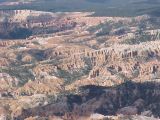 What can I say about Bryce Canyon that hasn't already been said?
When I'm not at
Zion,
it's my favorite place in the world.
The rocks, the colors, the general shape of the place
speak to me
in a wonderful way.
When I learned to
fly,
one of my fantasies was to fly there myself,
to see it from the air on my own wings,
and to visit the park after landing at
Bryce Canyon Airport (BCE).
(Taking off from the high elevation and thin air at BCE
(2300m, 7600', 765mb)
to get back home wasn't part of the fantasy,
but definitely is part of the reality
of any flying in the mountains.)
On 2004 April 16 I actually got to do it.
What can I say about Bryce Canyon that hasn't already been said?
When I'm not at
Zion,
it's my favorite place in the world.
The rocks, the colors, the general shape of the place
speak to me
in a wonderful way.
When I learned to
fly,
one of my fantasies was to fly there myself,
to see it from the air on my own wings,
and to visit the park after landing at
Bryce Canyon Airport (BCE).
(Taking off from the high elevation and thin air at BCE
(2300m, 7600', 765mb)
to get back home wasn't part of the fantasy,
but definitely is part of the reality
of any flying in the mountains.)
On 2004 April 16 I actually got to do it.
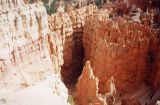 The flight from
Scottsdale (SDL)
to BCE
is about two and a half hours in my airplane,
a Piper Cherokee PA28-140.
I took off at sunrise to beat the heat
and to have as much time as I could in the park on Friday.
I had to fly
high
to follow the rules of the special use airspace over the
Grand Canyon.
The mountains of Utah look just as strange from the air
as they do from the ground,
unearthly shapes and moonscape visions.
One wag says you should see Utah with one eye closed
so it only looks half as strange.
The flight from
Scottsdale (SDL)
to BCE
is about two and a half hours in my airplane,
a Piper Cherokee PA28-140.
I took off at sunrise to beat the heat
and to have as much time as I could in the park on Friday.
I had to fly
high
to follow the rules of the special use airspace over the
Grand Canyon.
The mountains of Utah look just as strange from the air
as they do from the ground,
unearthly shapes and moonscape visions.
One wag says you should see Utah with one eye closed
so it only looks half as strange.
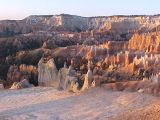 Bryce Canyon has a special charm.
If the
Grand Canyon
is about looking down
and Zion is about looking up,
then Bryce is about eye-to-eye intimacy
with the rock formations.
The rock somehow formed into columns called "hoodoos"
that eroded unevenly to give them human-scale shapes,
rows of souls frozen in stone.
The appeal of Bryce is in its intricacy of shape and color
and the intimacy of its spaces.
The vastest view of the Bryce amphitheater
is a few miles,
tiny compared to the spaces of the Grand Canyon or Zion.
The combination of iron, sulfur, magnesium, and copper
in the rocks
create a color display that photos only allude to.
Fractile-like,
the patterns of Bryce exist on many scales
as the erosion has shaped the rocks from
amphitheater scale to human scale
to finger-sized scale in the cracks and texture of the rock.
I'm told Bryce Canyon has 240 freeze-thaw cycles
in its daily temperature cycle,
more than anyplace else,
and the almost-nightly expansion of water into ice
has shaped these rocks over the millennia.
(Picture Carl Sagen referring to
"billions and billions of years"
with his heavy emphasis on the B in "billions"
as he did in his television show "Cosmos.")
Bryce Canyon has a special charm.
If the
Grand Canyon
is about looking down
and Zion is about looking up,
then Bryce is about eye-to-eye intimacy
with the rock formations.
The rock somehow formed into columns called "hoodoos"
that eroded unevenly to give them human-scale shapes,
rows of souls frozen in stone.
The appeal of Bryce is in its intricacy of shape and color
and the intimacy of its spaces.
The vastest view of the Bryce amphitheater
is a few miles,
tiny compared to the spaces of the Grand Canyon or Zion.
The combination of iron, sulfur, magnesium, and copper
in the rocks
create a color display that photos only allude to.
Fractile-like,
the patterns of Bryce exist on many scales
as the erosion has shaped the rocks from
amphitheater scale to human scale
to finger-sized scale in the cracks and texture of the rock.
I'm told Bryce Canyon has 240 freeze-thaw cycles
in its daily temperature cycle,
more than anyplace else,
and the almost-nightly expansion of water into ice
has shaped these rocks over the millennia.
(Picture Carl Sagen referring to
"billions and billions of years"
with his heavy emphasis on the B in "billions"
as he did in his television show "Cosmos.")
As the United States National Park Service can explain in greater detail, Bryce Canyon isn't really a canyon, but the edge of a plateau where the higher gives way to the lower in an astounding array of wonderfully-shaped rock formations. By national-park standards, Bryce Canyon is a small park, about 30 Km (20 miles) north-to-south and 10 Km (6 miles) east-to-west with a roadway and many viewpoints on the west, high side. The rock formations, "hoodoos," are columns of rock a few meters tall, human scale, that cover the hillside and congregate in one area into a spectacular scene called the "amphitheater." At nightfall the landscape fades while myriad stars appear in an exceptionally dark sky.
There are hiking trails down to and along the east, lower side.
Walking along these pathways
an
inexperienced
hiker can enjoy the hoodoos up close and personal.
There are hills along these trails,
but nothing requiring any sort of mountaineering,
no chains to hang onto,
no serious hazards beyond fatigue, dehydration, and sunburn.
My usual trip to Bryce Canyon
has me hiking first, while my feet are fresh,
then driving to all the viewpoints the entire length of the park,
and then hiking other trails.
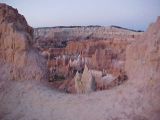
|
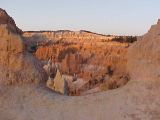
|
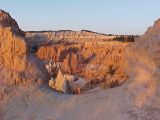
|
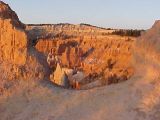
|
The variety of minerals in the rocks give Bryce Canyon a variety of colors that change with the lighting. I took these pictures at Sunrise Point in the hour from first light to full morning sun. The camera's automatic exposure meter makes them appear to be the same brightness, so the pictures show only the differences in contrast and color as the sun rises. The change in color and texture in these pictures is not an illusion of the camera as I see the same changes when I am there myself.
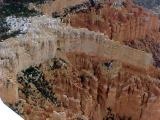 There isn't much to say about Bryce Canyon, really.
Those who have been there don't need me to try to describe it
and those who haven't aren't going to be inspired by my words,
even with cool web-site thumbnail
photographs.
There isn't much to say about Bryce Canyon, really.
Those who have been there don't need me to try to describe it
and those who haven't aren't going to be inspired by my words,
even with cool web-site thumbnail
photographs.
On the subject of mountain flight, however, I have some more to say. Big mountains can eat little airplanes for breakfast and flying in and around them demands respect. That respect comes in the form of terrain planning and weather planning. It is easy to get lost (or to have "a temporarily lapse in situational awareness" if one doesn't want to admit actually being lost), so having some extra fuel and leaving some extra time are good things to do. There are similar-looking plateaus around Bryce Canyon and it took me a few minutes to realize the one I was near was too high an altitude and not quite the right shape.
Familiarity is everything in the mountains. One experienced mountain pilot said, "If you can't see the tops, the mountains all look the same." Well, if you don't know the mountains, then they also all look the same. The only way to become familiar with a region is to be there many times. Well, there has to be a first time and that time is going to be an adventure flight with a lot of looking around and cross-checking visible landmarks and features on the aviation charts. A little humility, being comfortable with some confusion, goes a long away in making mountain flying more fun than frustrating.
|
13:15:06 Mountain Standard Time (MST). 7730 visits to this web page. |